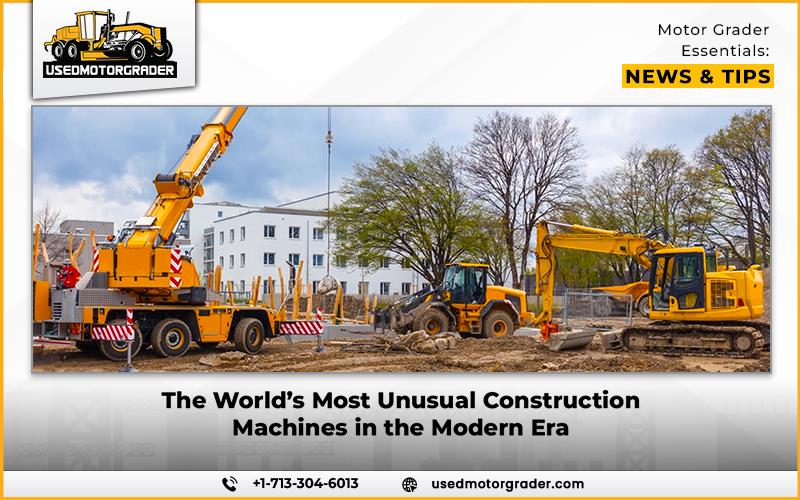Floating, Climbing, and Tunneling
The common idea of construction machines involves thoughts of bulldozers reshaping dirt or cranes holding steel beams. The heavy machinery world includes many types of machines beyond what you observe at basic construction projects. Specialized construction machines work in the most challenging and isolated locations on our planet to move large objects. These remarkable machines are built in many forms, such as floating dredgers working in water and tunnel boring machines burrowing through underground depths. Both serve to achieve impossible tasks. The construction industry keeps expanding into extreme conditions, which drives the creation of extreme machinery.
Machines That Float: Aquatic and Amphibious Construction Equipment
Building in waterlogged areas needs unique construction methods that differ from normal land projects. Construction machines built for water work need floating and walking abilities, plus the skills to operate on wet ground, which ordinary excavators cannot handle. Amphibious excavators maintain operation as they float with their textured undercarriage and waterproof cabin. These machines serve essential roles during levee maintenance work and wetland construction projects. These excavators depend on both pontoons and specific paddle devices instead of traditional wheel or track systems. Their special buoyancy feature helps them work safely in soft-bottom areas and supports coastal protection efforts during flood risks.
Tunneling Titans: The World Beneath the Surface
Regular construction equipment cannot handle projects below ground level. Tunnel boring machines stand out as huge cylindrical machines that can cut through different ground types like rock and clay. These machines excavate soil while building support systems and dispose of debris while keeping the walls stable. Their technology-controlled operation lets them build tunnels long distances without damaging the earth above. These machines make underground engineering work possible by installing support systems and creating utility networks beneath the ground. The demand for underground construction will keep increasing because cities continue to become more crowded.
Sky Climbers: Construction on Vertical Faces and Cliffsides
The traditional earthmovers cannot work on steep slopes or vertical cliff surfaces. The spider excavator works as a climbing machine that does jobs other earthmovers cannot handle. The machines adjust their legs and arms while spinning 360 degrees to handle rocky and slick terrain at extreme angles. Their slim body shape and stable base position enable them to stick to steep slopes despite the force of gravity. These machines successfully perform slope stabilization work while drilling cliffs and excavating in high altitudes. Their robotic movements make them seem like an animal-like device that climbs challenging areas that few humans could survive.
High-Altitude Machines: Building in the Clouds
Building projects at height require special solutions because of reduced air pressure, cold temperatures, and remote locations. Machines meant for high-altitude work need to keep operating in difficult weather and environments. Cranes operating in those areas need metal strengthening and de-icing technology to handle extreme conditions. Platform systems need to be both easily portable by helicopters and built to support heavy workloads. Companies use both aircraft delivery and on-site construction processes to transport these machines to challenging mountain locations. The machines continue operating normally at high elevation and show that the sky isn’t the limit.
Desert and Volcanic Region Equipment
Some construction machines are built to withstand dangerous heat and dusty environments. Excessive heat plus mechanical strain become daily challenges for machines operating in desert and geothermal regions. Special cooling technology plus sealed electronics and strong filters protect machine parts from sand and volcanic dirt. Their tires and tracks stay firmly grounded and resist damage when working on loose sandy terrain. The insulation inside operator cabins supports both human safety and operating comfort levels. The equipment demonstrates its strength by working in areas where the ground itself can burn.
Custom Engineering for Custom Problems
When standard equipment fails to deliver the required result, custom machines need to be built. The engineers develop total system solutions that match a single task and specific conditions. Engineers study problem conditions such as terrain stability and space restrictions to create custom machines that solve those challenges. Engineers design custom machines that can handle hybrid tools and move in small parts while using robotic security in hazardous areas. Engineers put tremendous innovation into these machines despite their unique purpose, since they set new limits for heavy equipment machinery design. Every built machine serves as a prototype for modern industrial tools.
In Short
Construction machines built for tough settings display their greatest performance at such locations. These machines operate successfully under any extreme environment, from swamp depths to rock faces, down to underground passages. The expanding human development projects into urban areas, oceans, mountains, and underground spaces will require machines that function in these challenging environments. These advanced engineering creations work in hidden areas without other machines being able to match their performance. These machines work where no other machines can, and that, in itself, is a feat worth celebrating.


